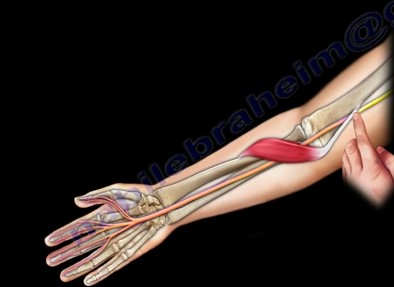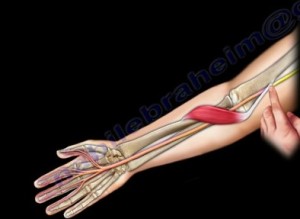Pronator teres syndrome or PTS is a condition marked by compression of the median nerve located near the elbow. The entrapped nerve goes through the 2 sections of the pronator teres muscle in the hand, thereby resulting in numbness, pain, and tingling sensation in the hand and forearm. The condition is more common in individuals aged between 40 and 50 years.
The median nerve passes across the forearm and the hand. Along this path, it is possible for the nerve to become compressed. Carpal tunnel syndrome or CTS is a similar condition that consists of median nerve compression, but at the wrist instead of near the elbow as is the case with pronator teres syndrome. CTS is also more prevalent than pronator teres syndrome.
Symptoms of pronator teres syndrome
The median nerve present in the upper extremities provide the sensation of touch in the skin of the thumb, palm, bones of the wrist, and the middle, index, and half of the ring finger. Hence, compression of this nerve will lead to adverse symptoms on the forearm and near the elbow as well as in the hand.
As the median nerve is affected in both carpal tunnel syndrome and PTS, most signs and symptoms that accompany pronator teres syndrome are similar to those experience by CTS patients. However there are some major differences as discussed below:
- The most common symptom associated with pronator teres syndrome is tingling sensations and pain in the palm, forearm, and fingers. Such neural symptoms are absent in CTS patients.
- Stiff fingers or limited finger movement may be evident. This is because brain signals need to pass via the entrapped or compressed point.
- The pronator teres muscle may be tender to touch; this is not so in case of CTS.
- Patients may experience pain in the forearm. Such forearm pain is not experienced by people with CTS.
- Moving the wrists does not lead to worsening of the symptoms of pronator teres syndrome.
- CTS patients generally suffer from night pain, while this symptom does not occur in PTS patients. The symptoms also do not aggravate during night in PTS patients.
Causes of pronator teres syndrome
- Pronator teres syndrome is caused due to compression of the median nerve in the proximal section of the forearm or at the elbow, usually due to excess pressure exerted by the pronator teres muscle on the nerve. It may be noted that the pronator teres muscle is essential in carrying out motions such turning the palm behind, downwards, or away from oneself. In pronator teres syndrome, the median nerve typically gets compresses between the two heads of the pronator teres muscle, often because of repetitive hand motions.
- Overuse of the pronator teres muscle or repetitive hand movements can be associated with certain jobs such as carpentry that requires sustained use of tools or continuous hammering, etc. as well as in some sports with overhand movements like badminton and tennis. The movements of a baseball batter can also trigger entrapment of the median nerve.
- Increased pressure on the median nerve by other arm structures such as the ligament of Struthers or hardening or thickening of the lacertus fibrosus/bicipital aponeurosis, as well as some kinds of structural anomalies can cause the median nerve to become entrapped in the elbow area, thereby resulting in pronator teres syndrome.
- Other causes of PTS include:
- Excessive exercising or frequent and strenuous workouts
- Formation of fibrous bands within the pronator teres muscle can trigger compression of the median nerve
- A pinched median nerve can also occur due to muscle hyper-tonicity.
Pronator teres syndrome test
Pronator teres syndrome can be diagnosed by the simple pronator teres diagnostic test. Doctors will ask a patient to stand and then fold the upper arm at the elbow so as to make an angle of 90 degrees. Then the physician will use a hand to support the elbow and slowly to turn the forearm with the other hand so as to contract the pronator teres muscles. People who experience discomfort and pain during this test may be suffer from compresses median nerve between the heads of the pronator muscle.
The extent of associated nerve damage can be verified via an EMG involving needle pricks and mild electric shocks.
Treatment of pronator teres syndrome
- The symptoms of pronator teres syndrome can be alleviated with massage therapy; it helps lengthen and release the pronator muscles and prevents worsening of the condition. The problem region needs to be correctly identified before proceeding with massage therapy.
- Physiotherapy and certain exercises can also help find relief from PTS symptoms.
- I.T.E., i.e., Rest Ice Therapy (physical or occupational) and Elevation is suggested for young athletes with PTS. If issue persists, then doctors may prescribe administration of corticosteroid injections into the pronator muscles.
- Surgical correction, including pressure alleviation on the median nerve at all possible locations along its path, is recommended in severe cases of PTS.
- Most patients experience full recovery via varied therapies in about 4 months, while healing may take nearly 18 to 29 months in other patients.

